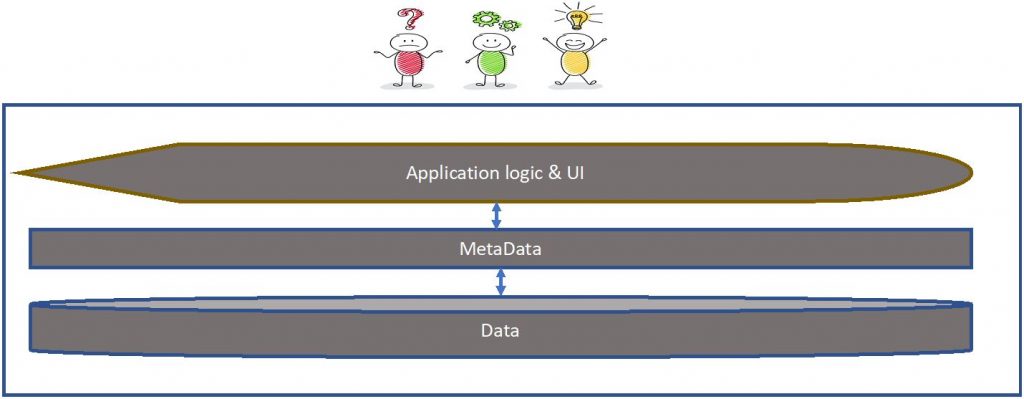We just finished a conversation with a client who was justifiably proud of having centralized what had previously been a very decentralized business function (in this case, it was HR, but it could have been any of a number of functions). They had seemingly achieved many of the benefits of becoming data-centric through decentralization: all their data in one place, a single schema (data model) to describe the data, and dozens of decommissioned legacy systems.
We decided to explore whether this was data-centric and the desirable endgame for all their business functions.
A quick review. This is what a typical application looks like:

The metadata is the key. The application, the business logic and the UI are coded to the metadata (Schema), and the data is accessed through and understood by the metadata. What happens in every large enterprise (and most small ones) is that different departments or divisions implement their own applications.
Many of the applications were purchased, and today, some are SaaS (Software as a Service) or built in-house. What they all fail to share is a common schema. The metadata is arbitrarily different and, as such, the code base on top of the metadata is different, so there is no possibility of sharing between departments. Systems integrators try to work out what the data means and piece it together behind the scenes. This is where silos come from. Most large firms don’t have just four silos, they have thousands of them.
One response to this is “centralization.” If you discover that you have implemented, let’s say, dozens of HR systems, you may think it’s time to replace them with one single centralized HR system. And you might think this will make you Data-Centric. And you would be, at least, partially right.
Recall one of the litmus tests for Data-Centricity:

Let’s take a deeper look at the centralization example.
Centralization replaces a lot of siloed systems with one centralized one. This achieves several things. It gets all the data in one place, which makes querying easier. All the data conforms to the same schema (and single shared model). Typically, if this is done with traditional technology, this is not a simple model, nor is it extensible or federate-able, though there is some progress.
The downside is that everyone now must use the same UI and conform to the same model, and that’s the tradeoff.
The tradeoff works pretty well for business domains where the functional variety from division to division is slight, or where the benefit to integration exceeds the loss due to local variation. For many companies, centralization will work for back office functions like HR, Legal, and some aspects of Accounting.
However, in areas where the local differences are what drives effectiveness and efficiency (sales, production, customer service, or supply chain management) centralization may be too high a price to pay for lack of flexibility.
Let’s look at how Data-Centricity changes the tradeoffs.




